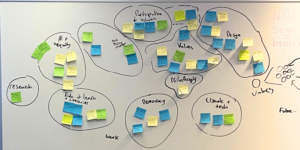by Katy Knight
In my role as SFE’s Executive Director, one of the core philosophies that I ask our team to keep top of mind is the belief that “context is key.” Having a fundamental understanding of the contexts in which our grantees work is critical to making grants that are informed and impactful, especially as we aim to find and fund the ideas and organizations that might otherwise be overlooked. We think about context in a number of ways. In this series of Insights, we’ll explore the different factors that inform a grantee’s context, and share the considerations that we prioritize in order to develop a better understanding of their grantees’ work.
In the philanthropic community, “context” comes up often in relation to impact and evaluation. But by the time we’re exploring whether or not a program has been successful, we’ve often missed the opportunity to be more thoughtful about how much context shapes and contributes to the very outcomes we’re measuring. As a field, we can do a better job of asking questions early on that help us better understand the circumstances that inform how organizations do their work. In this first post, I want to share some of the questions we ask ourselves in order to better understand the teams doing the work at a given organization.
- Who’s in charge? Leaders who fundamentally understand both the conditions of their work and their barriers to success are uniquely positioned to steward successful programs. I don’t bring this up to imply that, say, the only person who can lead a community-based organization is someone who was born in that community. However, there’s a lot of inherent value in being able to recognize nuances that might otherwise be hard to see. Leadership that’s grounded solely in an outside perspective practically guarantees that important, well-contextualized insights will often go overlooked. That’s why we seek out organizations with leaders – including executive directors, senior leadership, and board members – who possess “context knowledge,” strong relationships in the communities they seek to serve, and a commitment to being cognizant of the nuances that will ultimately impact successful outcomes.
- Who’s doing the work? Following closely on the previous point, it’s crucial that teams of all sizes are built with diversity of experience in mind, and that they reflect the communities where they work. It’s critically important to understand how program teams are developed and staffed, and what kinds of experience they leverage in the work they do on the ground. SFE partner New Profit’s Learn to Earn has recently begun work on an initiative on Diversity, Equity, and Inclusion in the college access and success space. One piece that’s particularly exciting to us is focused on contributing to the evidence base to “spur research efforts to document the types of DEI-focused efforts that are most effective in advancing outcomes”. This is a great example of the work that we need to do to augment our assessment of what makes a strong program team.
- How involved are members of the communities served? Is a nonprofit’s audience included as a stakeholder group guiding the organization’s strategy? Do staff and leaders at the organization value feedback? (Candid has developed great resources on this with the support of SFE grantee Feedback Labs) Involving the end user from the very beginning is a key part of making sure that an organization is using their resources effectively to meet actual, demonstrated needs in a way that reflects the communities where they work.
We advocate for more critical engagement in this space because we know that philanthropy, as a field, doesn’t always get this right. If we as grantmakers can do more to center the experiences of our grantees, our community will be better positioned to provide support that’s better tailored to their specific needs, and that sets them up to be more impactful in the long term. In order to hold ourselves accountable on this front, we’ve built questions like the ones above directly into our grant recommendation process. Formalizing this part of our process and weaving these values into our organization positions us to serve the communities we work with more effectively, and helps us more effectively pursue our mission.
This is our effort to articulate just a few of the important considerations that we believe help us do good work. We hope the broader philanthropic community will be able to lead by implementing practices like these more widely, and that others will share their own thought process as well! In the next post in our Context is Key series, we’ll explore our perspective on considering the context of place, and the ways in which understanding the “where” can help us better understand “how”.

Katy Knight is the Executive Director of Siegel Family Endowment





